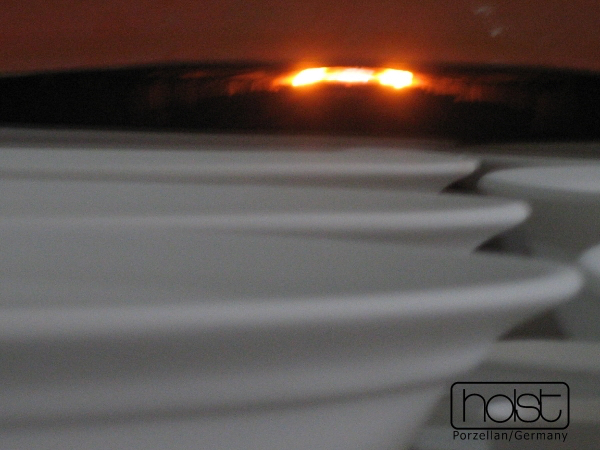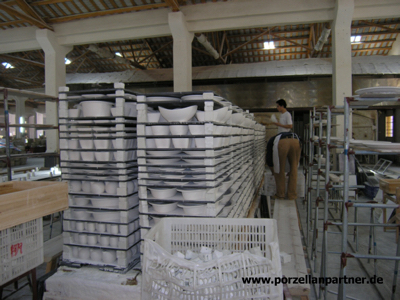Hard firing
The hard firing in the porcelain industry

Mixed from the raw materials kaolin, quartz and feldspar, shaped and pre-dried, the glost firing takes place after the glaze has been applied. The unfinished porcelain body is in a bisquite-like state (green firing method) or in a leather-hard state (mono firing method). The following names and designations for this production step are applicable and appropriate
- Glaze firing
- Hard firing
- Sharp firing
- Glaze firing

The porcelain is placed on kiln cars and usually mixed according to fixed arrangements of hollow and flat parts. The process of "stacking" can take many hours and requires a steady hand in addition to a lot of experience. The picture above shows a two-part kiln car for a 56 sqm block kiln. The stacking process takes 4 employees about 6 hours - so in total one kiln charge in this production plant takes about 24 hours.
Now the firing process takes place, which turns the still moist, dark mass into the fine, light, white shining porcelain. During this firing process, the body is compressed in the temperature range between 1230 and 1,400 °C until it is completely sintered (vitrified).
Depending on the atmosphere in the kiln, the porcelain can be fired open, or must be placed in firing capsules in the case of carbonaceous gas or very thin types of cullet, so that no hazy residues such as streaks and nebulisation are left on the porcelain. Red-hot, the earthen base materials survive firing and are subject to incredible physical influences during the firing process.
The quality of the burning fuel plays an important role in the visual impression of porcelain. The firing time depends on the pre-firing and can last from 4 to 40 hours.
The main part of our porcelain collection is fired in long, between 69 and 80 meters pleasant, modern and energy-efficient tunnel kilns. Behind the kiln door every porcelain is the same! Whether with - without, with green or blue bottom mark, with coat of arms, ornament, swords or sceptre, they all have earthen raw materials and a hard firing of more than 1,320 °C behind them.
